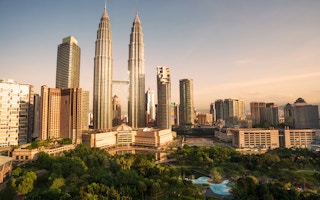The biggest and best opportunities are most often found in cities. This is the view that is driving increasing levels of urbanisation around the world, especially in Asia, which has the world’s fastest rates of urban growth. In fact 1.4 billion more people are expected to be living in Asian cities by 2050 compared to today. This additional number is greater than the entire world population in 1850.
To continue reading, subscribe to Eco‑Business.
There's something for everyone. We offer a range of subscription plans.
- Access our stories and receive our Insights Weekly newsletter with the free EB Member plan.
- Unlock unlimited access to our content and archive with EB Circle.
- Publish your content with EB Premium.
Cities are currently responsible for 70 per cent of the global greenhouse gas emissions from energy consumption, and are key to overcoming the challenge of reducing global carbon emissions. There is enormous potential to reduce these emissions through cost-effective energy efficiency measures that can deliver immediate cost and carbon savings, while also strengthening the local economy and creating a better place to live.
As urban populations in Asia have continued to grow and become more economically prosperous, this has led to a corresponding increase in their consumption of energy and key resources. That means that when it comes to sustainability, it is certainly true that the biggest and best opportunities are most often found in cities.
Cities provide the ideal environment for transformative change and innovation to take place rapidly and at a significant scale. This is something that we are hoping to prove in Malaysia as the Carbon Trust, a UK-based company specialising in international carbon reduction and resource efficiency, launch a new low carbon cities programme, working alongside Malaysian Green Technology Corporation (GreenTech Malaysia).
In 1970 barely a quarter of Malaysia’s population lived in cities. Today three out of four Malaysians live in an urban environment, and the proportion continues to increase. Alongside this urbanisation there has been a period of remarkable economic growth, leading to an explosion in energy demand and carbon emissions. More importantly, this has massively increased the levels of air pollution, harming the health of those that live in cities with a thick haze of fossil fuel fumes.
Malaysia’s average per capita carbon footprint is around twice that of Thailand, four times higher than Indonesia or Vietnam, eight times that of the Philippines, and twenty-four times greater than in Cambodia (although it is just half that of Singapore).
The size of the opportunity to improve both energy efficiency and air quality of Malaysia’s cities is exciting. Recent research from the Centre for Low Carbon Futures, looking at the city of Johor Bahru and nearby town of Pasir Gudang, both in Iskandar Malaysia economic development zone, uncovered the potential to reduce energy bills by more than RM 2.5 billion – and carbon emissions by nearly a quarter – through investments in energy efficiency and low carbon development in areas such as transport and waste, that would pay for themselves little more than a year.
“
Today three out of four Malaysians live in an urban environment, and the proportion continues to increase. Alongside this urbanisation there has been a period of remarkable economic growth, leading to an explosion in energy demand and carbon emissions.
Innovative technology is playing its part too. Malacca has a stated ambition to become a low carbon green city by 2020, and is currently taking the first steps towards creating a smart electricity grid. This is being done as part of an initiative to create a Green Special Economic Zone where it is intended that as many as 20 research and development centres will be built focusing on renewable energy and clean technology, creating as many as 300,000 new green jobs.
The Carbon Trust’s work on low carbon cities in Malaysia builds on more than a decade of experience running major energy efficiency programmes for businesses and public sector organisations around the world, including in the UK, China, Mexico and South Africa. It is estimated that the impact of these Carbon Trust programmes includes saving over 50 million tonnes of carbon dioxide, as well as delivering cost reductions of more than US$9 billion for participating organisations.
The Carbon Trust’s work in Malaysia is beginning with a two year pilot working with one Malaysian city, made possible with funding from the UK Government’s Foreign and Commonwealth Office.
In the first year this will involve identifying detailed opportunities, developing a robust carbon management strategy for the city, and implementing energy efficiency measures within the city’s own administrative estate.
The second year will see the city lead the way in driving area-wide carbon reduction. This will involve co-ordinating large projects, and collaborating with local stakeholders, businesses and other organisations to create inspiring examples for other cities to follow.
The Carbon Trust is currently looking for Malaysian city government organisations that would like to get involved, either in the pilot phase or the wider roll-out of the low carbon cities programme. Interested parties should speak with the Carbon Trust or GreenTech Malaysia.
We believe that this programme has the potential to help the Malaysian public sector become a low carbon leader in Asia, at the same time building stronger relationships between Malaysia and the UK. Most importantly, it will ensure that as Malaysia’s cities expand, that growth will be both greener and cleaner for Malaysia’s population and the planet.
Richard Rugg is Managing Director of Programmes at the Carbon Trust.











